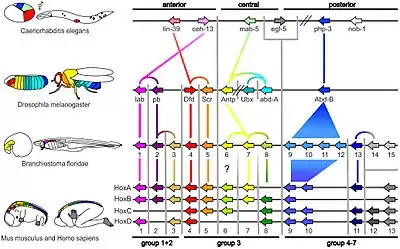Portal:Evolutionary biology
Introduction
Selected article -Genetic drift, also known as allelic drift or the Wright effect, is the change in the frequency of an existing gene variant (allele) in a population due to random chance. Genetic drift may cause gene variants to disappear completely and thereby reduce genetic variation. It can also cause initially rare alleles to become much more frequent and even fixed. (Full article...)General images -The following are images from various evolutionary biology-related articles on Wikipedia.
Selected picture - Thylacine The last known Thylacine photographed at Hobart (formerly Beaumaris) Zoo in 1933. A scrotal sac is not visible in this or any other of the photos or film taken, leading to the supposition that "Benjamin" was a female, but the existence of a scrotal pouch in the Thylacine makes it impossible to be certain Did you know... -
CategoriesCategory puzzle Select [►] to view subcategories
Evolutionary biology Subfields of evolutionary biology History of evolutionary biology Evolutionary biologists Evolution-related lists Evolutionary biology literature Evolutionary biology terminology Assistance Evolutionary biology concepts Darwinism Digital organisms Evolution of the biosphere Extended evolutionary synthesis Hybridisation (biology) Last common ancestors Modern synthesis (20th century) Molecular evolution Non-Darwinian evolution Organisms by adaptation Origin of life Paleontology Evolution by phenotype Population genetics Evolutionary biology societies Evolution by taxon Transitional fossils Vestigial organs Related portalsRelated subjectsTopics in biologyTasks you can do
Related topicsWikiProjectsWikiProjects connected with biology:
A complete list of scientific WikiProjects can be found here. See also Wikispecies, a Wikimedia project dedicated to classification of biological species. Associated WikimediaDiscover Wikipedia using portals
|








_1_by_N._A._Naseer.jpg.webp)






![Image 15A covalent adduct between the metabolite of benzo[a]pyrene, the major mutagen in tobacco smoke, and DNA (from Mutation)](../I/Benzopyrene_DNA_adduct_1JDG.png.webp)



_nyererei_male.jpg.webp)
.jpg.webp)






.jpg.webp)


